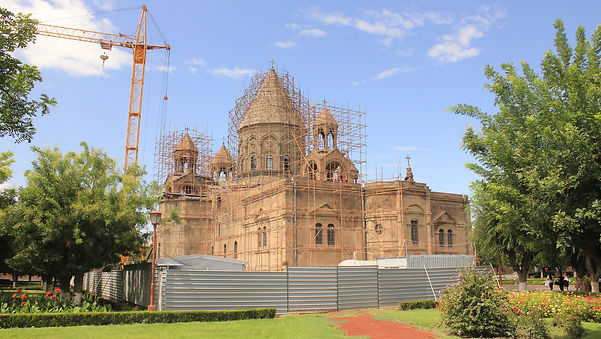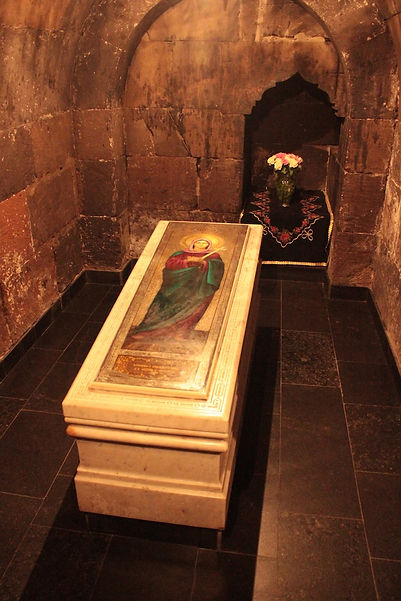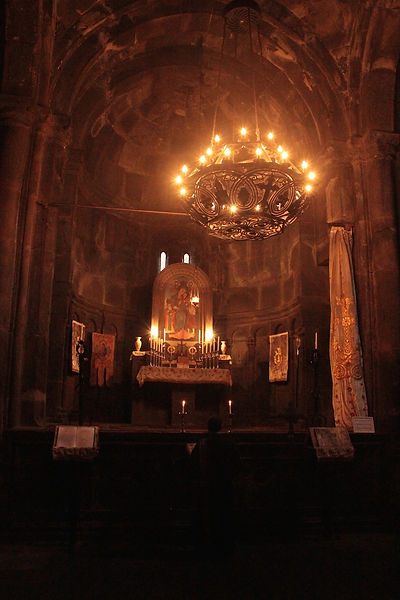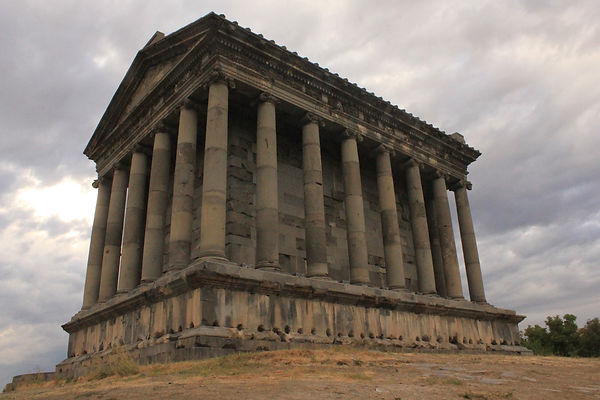
Day 1: First things first: Mother See of Holy E✝chmiadzin
Armavir Province, Vagharshapat
As exhausted fellows, we could only wake up around 10 o’clock in the morning. As planned, we had to visit three different places including two Cathedral complexes, and a Temple. In an hour, all of us were ready waiting at the hostel’s door for departure. From Yerevan Kentron (city center), we drove approximately 25 kilometers to the Cathedral compound of Mother See of Holy E✝chmiadzin. It almost took an hour to get inside the complex. The holy atmosphere captures your soul with its divine power and you start feeling blessed. Wandering around the Cathedral complex, you come across different types of buildings including the E✝chmiadzin Cathedral (see first picture below), Gevorkian Theological Seminary, Christian Education Center, Armenian Genocide Memorial, Pontifical Residence, Printing House, Open air Altar and the Clock Tower.
The E✝chmiadzin Cathedral, as cited by several various authors, is the oldest Cathedral ever built in world history, which makes it unique all over the world.

You may check the link here for further information
The original church was built by Armenia’s patron saint Gregory The Illuminator’s order. He is still known as the first Catholicos of all Armenians. In year 301, under the command of Tiridates III (Tiridates the Great), The Kingdom of Armenia became the first country to adopt Christianity as a state religion. The church was built right after the recognition of Christianity in the years between 301 and 303. Thus, E✝chmiadzin Cathedral has become the first seat of the Catholicos of Armenians.
Here I include some more photographs from the complex.





The world-known ritual of the Cathedral is the Holy Muron ceremony, which occurs every 7 years repeatedly. This Holy anointing oil, spread from there to the rest of world churches, contains some drops of the previous oil served. The procedure has been followed for nearly 1700 years. Therefore, the newest Holy Muron always contains a small amount of the original, blessed by Moses, Jesus Christ and the Gregory the Illuminator. The Holy Muron consists of olive oil, forty-eight aromas and flowers.
Proceeding our tour around the complex, we stopped by another breathtaking Cathedral called Surp (Saint) Hripsime Cathedral. This cathedral is counted as one of the major Cathedrals in Vagharshapat (E✝chmiadzin).

The others are St. Gayane Church and Shoghagat Church.
As seen in the picture, St. Hripsime Cathedral still keeps its beauty. The most significant thing about the Cathedral is that in its courtyard it shelters two of Catholicoi (Asdvadzadur and Garabed II) from the 18. Century. Moreover, St. Hripsime’s tomb can also be observed (as seen in the picture below) in the catacombs of the church.

Second half of the day: In pursuit of UNESCO World Heritage list
Kotayk Province, Geghard & Garni
Now it’s time to move on to another magnificent Monastery complex that is also in the UNESCO World Heritage list. On the way back from the West of Yerevan to East, we were driving on an interstate road. All of a sudden, our lane was sharply cut by a careless local driver. He didn’t even know what he was doing. In a second, having realized what he had done, he abruptly reduced speed to get close to us. He swung his left arm in the air from one side to another asking for an apology. I couldn’t believe my eyes to be honest. It was really hard to see this kind of a polite man on the roads nowadays. This episode remained in my mind as a good courtesy sign of polite Armenian people.
Circumnavigating the Kentron to the South-East direction, en route, we made some pauses to capture scenic views of the great mountains.


Besides the magnificent panoramic views, gangs of cows and bulls intermitted our journey to ancient remnants. We occasionally watched them trespassing the roads across the highlands. They cared about no other creatures except themselves. Nonetheless, I really enjoyed their existence. You would never get bored of driving around the hillsides experiencing a real life contact with these animals.

Back to the topic, our drive took us to the Geghard Monastery. This amazing structure, partially carved out of a mountain, is situated at the end of the road beneath the gorge of Azat River. To give some historical background, the Monastery was discovered in the 4th century by the Gregory the Illuminator. World history had to wait for the main cathedral to be built until 1215. Around the territory, several wars had taken place by then. The complex suffered pillages, serious threats and attacks by invaders coming from various lands. Actually, in the beginning the monastery was called Ayrivank (The monastery of the cave). With the construction of the main cathedral in 1215, its original name was altered to it’s current one. Geghard corresponds to the meaning ''the Monastery of the Spear''. Climbing up to the Cathedral complex via an inclined pave path, you see numerous Khackars (Armenian cross-stone). The Cathedral complex also hosts various caves to shelter nomads in wintertime.




For more detailed information please follow the link.
On the same road back, we had one more place to visit that was also in the World Heritage list by UNESCO, namely The Garni Temple. Once inside the parking areas of those sites, you are being welcome by locals asking for the parking payment. The price is standardised. You hand 200 AMD (Armenian Drams) to the person saying Hachohutyun (wishing good luck and success in Armenian).
The name of the fortress originated from the name of the country (race) Giarniani, which existed in this territory in the 8th century BC. Just like Geghard, Garni has also suffered from invaders and numerous battles. The biggest damage it faced was the devastating earthquake in 1679. The 1679 Armenian earthquake, with a 6.4 surface wave magnitude, caused a total collapse of the structure. While the building was damaged very seriously, there came a reconstruction plan to revive the building from its ruins. In 1968, Soviet Armenian government approved the reconstruction plan and the reconstruction works were completed in 1975 after 6 years of hard work. Following the opening of the new temple, Alexander Sahinian, an Architectural historian, was honored with a monument dedicated to his leadership in the reconstruction of the temple. The monument was erected near the temple in 1978.
What makes the temple more interesting is its unique geometrical design. The temple is a type of classical ancient Greek Architecture. While some scholars claim the structure to be Greek, others regard it Roman and some others think of it as having a bit of both. In addition, some even claimed the type as Armenian-Hellenic emphasizing the Armenian influence on the design. According to its unique design, the temple was considered to residing a sacred geometry. Ancestral Armenians built their lives according to the natural laws. They designated their shelters abiding the Pythagorean theorem. This resulted in specific geometric shapes and so-called sacred numbers, which were believed to have special symbolic meanings.
For instance, the number 1 represents the universe, 2 division, 4 the seasons and time, 7 completion, and 8 new life. Of these numbers, the most sacred ones were 3 (representing the trinity and the holy triad in Armenia Aramazd, Anahit and Vahagn) and 6 (for perfection), while 9 being the holiest of all numbers. Throughout the temple, those sacred measures can be observed in different combinations.



For further information click the arrow
Close to the sunset, our first day in Armenia was almost over. Fulfilling our lungs with historic scent of ancient Armenia on the outskirts of the Kentron Yerevan, we started our engine towards the modernized city center. From that moment on, I had no idea that my journey in Armenia would change totally and became a road trip of a solo traveler. The first night showed clearly that the rest of the group were likely to have different plans with some other friends. Without saying a word and any sign of objection, I predicted what was coming next. Keeping my calm, I separated myself from the group and headed to sleep until they called me for a meeting to discuss our journey plans for the rest of the days. At the end of the meeting, we understood there was no way for a compromise, so I started rescheduling my own plan. At least we had one more day together to re-analyze the situation. In fact, I had no idea what Armenia could offer me in that moment without my friends.
I didn’t know that, the more I explored, the more satisfaction I would get on my own.
